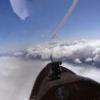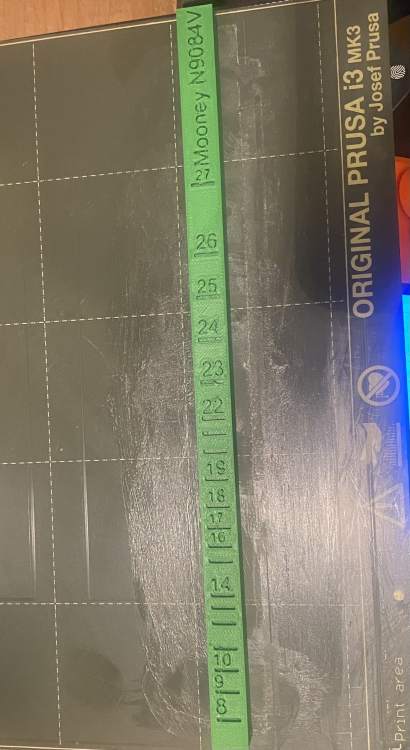-
Posts
38 -
Joined
-
Last visited
Steveolyo's Achievements
-
I wanted to double check the numbers I got so this time I completely emptied the bladder tank by removing the sampling valve. I then filled the bladder tank but it would only take 25.5 gallons. even that was too much because the level is right up to the rim, leaving no room to put on the gas cap. I don't have any documentation to confirm that the capacity can or can't drain out of that wing drain. Based on the above post, maybe @DXB would know. Is there another 1.5 to 2 gallons still usable at a lower level in the bladder?
-
Heated floors would be nice. In Utah it would help 6 months out of the year. I've got more pressing things though. This time of year (October) we have spider invasions in the hangar.
-
The measurements I made track fairly well. There is a bit of variation, expecially from the DXB numbers which are sparse since it is only given in 2 inch increments: 2,4,6; 4 data points compared to TTaylors 12 data points and my 19 data points. At 2 inches TTaylor and I match at 13 gallons, but then at 4 inches we differ by more than a gallon. That trend of differing a gallon or more continues until 24 gallons at 6 inches, where all three sources converge again. I will probably do the experiment again. It's tough to drain those tanks. I removed the drain plug to drain the tank and I probably should have had my buddy with me to help because that gas comes out very fast and fills 5 gallon cans really quick. After I filled the 5 gallon tanks, I used a 1 gallon can to measure each gallon and fill the tank. I waited about 2 - 5 minutes in between to give the tank time to settle before measuring. I started with the gas barely covering the bottom of the visible rubber bladder tank. Assuming that is 6 gallons could be off by a bit, so I'd really like to start with 0. Then you need to consider how much of that gas is unusable. I looked through the engine log, the airframe log and the weight and balance sheets but I can't find a mention of unusable fuel with the install in 2002 of the ON bladder tanks. I have heard on this site of a mention of 2.X gallons of unusable fuel in the bladder.
-
I made a pvc pipe handle, but I usually just contort. I've only flown with a mooney CFI once. I was in Florida on vacation. I live in Utah, so that's how far I had to go to find one
-
I finally drained the right wing tank and filled it up a gallon at a time. I took the data and printed this stick.
-
Does CEIS work on a bladder tank? I don't see how it can account for the last 6 gallons.
-
I've never run a tank dry. I'm frankly too worried that the engine won't come back on to try it. The valve switch being where it is I have to contort to get to it, so it takes me a few seconds of contortions to get to it.
-
I have the plane in a nice hangar. The scales are wireless and only about 1" thick. I know there is an A&P who does W&B with scales out of Evanston, WY. With all the changes to a plane over the years a real number would be nice to have vs. calculations which I know aren't 100% accurate. For example when I look through the logs at radio installations, the arm is sometimes calculated from the front of the radio and sometimes from the back. Probably should be calculated from where the COG of the radio is. I'm sure these are minor differences especially compared to whether you sit in the plane with the seat scooted all the way back, vs all the way forward. On the other hand, scales can be off a little as well so getting a true calibrated weight might be near impossible. I've had the plane for 6 years, so it's not new to me, but I usually fly well within the envelope with full tanks. It's only the times with 4 people in the plane that I obsess over W&B and need to know the true fuel weight. Thanks for the advice. I'll mark a stick now that I need to know.2
-
Thanks. I'll be emptying tanks and marking a stick. I'll see how it matches with yours.
-
Yes that does seem like a strange way, but we're all strange in different ways. I would have the plane completely empty. I probably wouldn't do this. But it would be good to know the weight of the plane from an actual measurement to be sure its not overloaded. Every summer there is at least one local problem or crash from an overloaded plane and for me and my family our weights have gone up. My two kids and wife and myself have a combined weight of 640 lbs, 80lbs for baggage, the plane weighs 1701, that brings the total to 2420, and the max takeoff is 2740 so that leaves 320lbs for fuel or 53 gallons. So as an experiment, or final check, I'd like to actually weigh the plane loaded and see if the weight matches the calculated weigh
-
I don't have metal tabs hanging down. Maybe they were taken off when the previous owner upgraded to bladder tanks, or maybe they were. not originally there.
-
I have a '69 F model with bladder tanks. It burns about 9 gallons an hour. In the past I have flown with full tanks but now my teenagers weigh more so I need to fly with less fuel on trips. I don't know an accurate way to gauge the fuel in the wings. Because the bladder tanks don't show any gas when there is still 7 or so gallons left and I don't have a stick that is calibrated, I would like to know what other mooney pilots have used to determine less than full tanks. Like say 20 gallons in each wing. I've thought of getting a scale like those used on race cars to weigh 4 wheels simultaneously. Then I would be able to calculate how much fuel I have based on weight. Has anyone heard of that? Oh, I've also used the gauges, not sure how accurate they are on the bladder tanks. I'd like to hear your ideas and comments.
-
I recently flew to a distant airport to do touch and go's. As I approached I noticed some patchy snow and ice on the paved surface. As I got closer I could see streaks of ice and snow chunks down the length of the runway. There were clear patches of asphalt that ran the entire length with lots of snow and ice that looked like it had been through a freeze-thaw cycle or two. Current temps were around 24 degrees F. Just into ground effect, I aborted the landing and returned to my regular airport where the runway was completely clear. I wasn't confident that I could land without hitting some of the snow ice chunks. I've never attempted landing in those conditions, but at 70MPH it would be a rough ride in a truck, so I knew the plane might not fare well. I'd like to hear about your experiences landing on runways with some snow or ice and how much effect those conditions had on your landings. Did I make the right choice? Should I have landed just to gain the experience? Sent from my iPad using Tapatalk
-
Airspeed Indicator not zero at Rest
Steveolyo replied to Steveolyo's topic in Vintage Mooneys (pre-J models)
How do you get at that drain? I tried from inside, from under the wing, from an access panel. Couldn't find a way to open that valve to clean it. Please share. -
I agree with Piloto. My transponder was reporting erroneous information to ATC. After pulling the contacts and cleaning them and carefully plugging them back in the transponder became accurate again.







